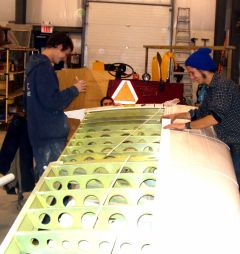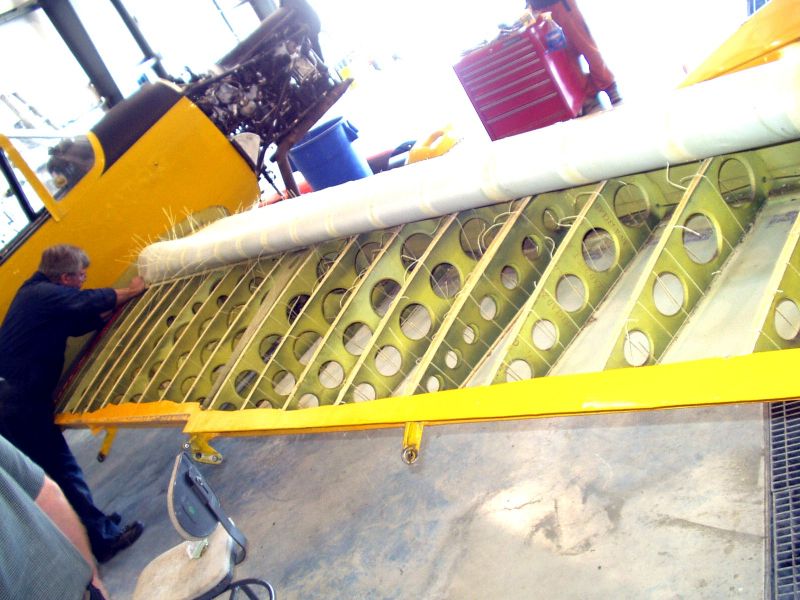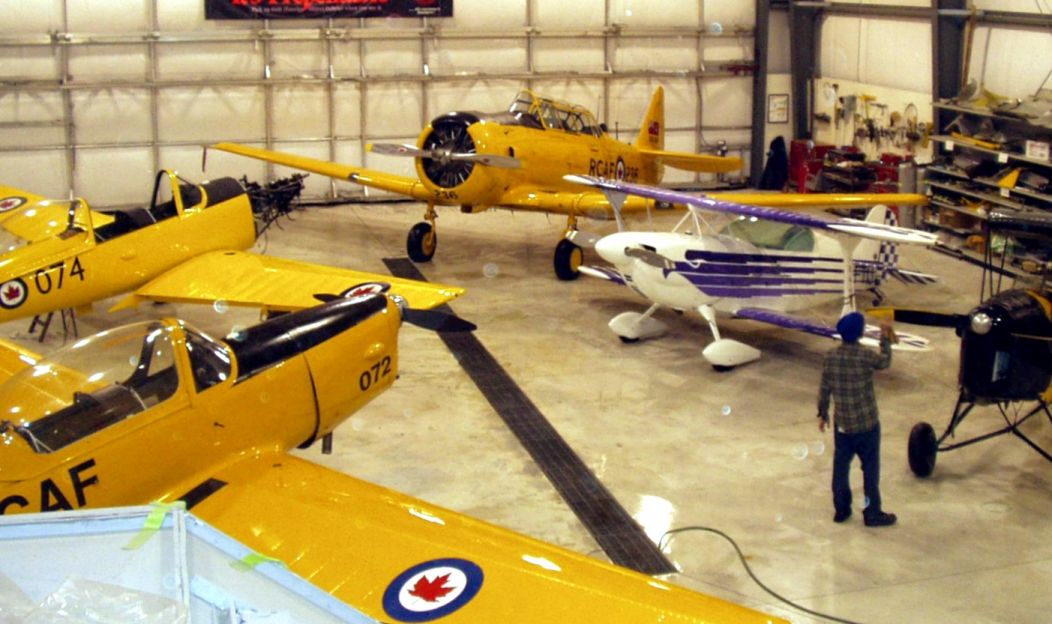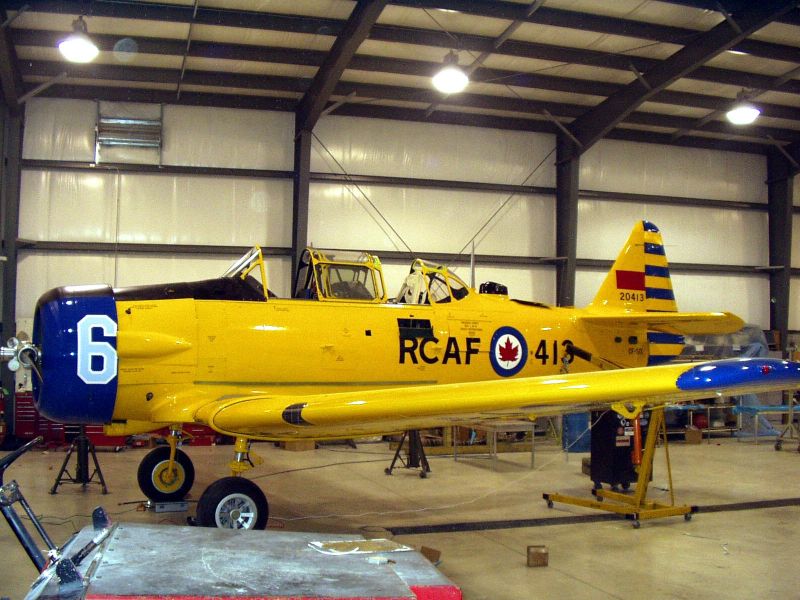
News
Extreme Makeover . . . Aircraft style!
 Old piston airplanes have a certain something. There is this aura they
exude - experience and credibility. They’ve been there, done that and
have nothing to prove – and we respect them for it.
Old piston airplanes have a certain something. There is this aura they
exude - experience and credibility. They’ve been there, done that and
have nothing to prove – and we respect them for it.
February 1, 2008 By Rob Seaman
 |
| Quality and craftsmanship count here. |
Old piston airplanes have a certain something. There is this aura they exude – experience and credibility. They’ve been there, done that and have nothing to prove – and we respect them for it. Older aircraft just look cool sitting there doing nothing but regardless of if you are in the cockpit or on the ramp, when they crank up – the hairs on the back of your neck get a rise. Jets just don’t do it the same.
Maurice Nesbitt feels the same way. That is why in the fall of 2001
Maurice (most know him as Mo) left the security of turning wrenches on
a corporate jet to start Oshawa based Corporate Aircraft Restorations
(CAR). Now the by the name alone you would think that these guys are
rebuilding Lears or Gulfstreams. You‘d be wrong. Think pistons and
props. They like their projects with some age and history to them. And
just to underscore that point, the team at CAR has grabbed not one, but
several top awards from Oshkosh and Sun n Fun for Harvard and Tigermoth
restorations. They also have a fondness for aircraft with names like
Noorduyn, Stinson and even the odd Cessna or Beechcraft.
Quality and craftsmanship count here. There is a great sense of pride in a job well done. Sitting amidst the newer developed north side of the Oshawa airport, the CAR hangar is simple, if not in fact understated. Walking in the front door, there are the obligatory photos of aircraft on the wall with a key exception – they are all ones that CAR has worked on. Going from the reception area to the hangar, you enter what is without doubt one of the cleanest and brightest maintenance facilities ever. The floor is clean, the shop space orderly and each project has its own distinct working area.
CAR is one of the places where visitors are truly welcome. Everyone in the place has a smile and a greeting. Old clients drop by when they are in the area just wanting to say hello, so you never know what may be on the ramp. It is also not uncommon to see a small tour of young people being escorted through. They are encouraged to stop and ask questions of the craftsman at work. Answers are willingly and happily given. Mo believes in sharing his enthusiasm and knowledge with the community and gives back some of their success. This is one of the reasons that CAR was named Entrepreneur of the Year in 2003 by the Greater Oshawa Chamber of Commerce.
 |
| This work is more of an art form – and the folks at CAR are truly artists. |
Craftsmanship and pride in a job well done are not things you hear a lot of in our rushed, quick service, massed produced society. This work is more of an art form – and the folks at CAR are truly artists. Many of the parts required to bring an old aircraft back to life are not available today, and that means they must be replicated – by hand. Walking around the hangar and looking at the various projects underway you see lots of this – old fashioned craftsmanship in action. Even the tug used to move aircraft into and out of the hangar is a vintage piece, but looks like it just rolled out of the paint booth. But it hasn’t – the guy’s just look after it – and everything else in the shop – that well. This sort of care and pride is what someone looks for when selecting a restoration facility.
 |
| The CAR hangar |
You have to look carefully to see what they have in house. For example, sitting neatly placed by the office door – and awaiting its turn for a new lease on life – is a true air racing legend – serial number 1, Travel Air Model R. This project now is now taking its turn in the line for renewal and rebirth.
In the event you are not familiar with it, back during the 1929 National Air Races, a sleek racing machine, built by the Travel Air Company of Wichita, Kansas came to the attention of the world. Design and construction started in 1928 – rumoured to be at the direct order of Walter Beech himself as he wanted a racer that would really make the grade and win. It earned the name "Mystery Ship" because its design and construction was so closely guarded at the factory. Even at its arrival for the 1929 air races, the aircraft was hidden from public view as long as possible. Names from the Golden Age of Aviation like Doug Davis, Walter Hunter, Pancho Barnes, Jimmy Doolittle and Jimmy Haizlip are all associated with the five Mystery Ships that were built.
Here are some of the highlights and facts associated with the Model R:
– constructed of steel-tube and plywood covered,
– wings all wood and also covered with plywood with a span of 29 ft. 2 in.
– The first famous "Mystery Ship", R614K – race No. 31, actually had two sets of wing panels – one set for closed course racing and the other for cross country flights and competition. The closed-course racing wings were about one and one half feet shorter in span and three inches narrower in chord.
– empty weight was 1,475 lbs. and a gross weight of 1,940 lbs. (gross included 47 gal. fuel capacity six gallons of oil).
– The Wright J6-9 engine was originally rated at 300 hp – 975 cu. in. displacement – but was upped to over 400 hp resulting in a top speed of 235 mph and a landing speed of 73 mph.
The aircraft now with CAR is a proven race winner and is now owned by the Staggerwing Museum in Tullahoma, Tennessee. It was flying as recently as the 1990s and will be rebuilt to flyable status while complete and authentic in every way. When finished, this will not only be a testament to the quality of work that CAR produces, but an honour they will all share in bringing this piece of aviation history back to life.

|
| Harvard Project |
Since first opening in February 2002, CAR has completed 20 major
aircraft rebuilds and slew of smaller maintenance projects. They
control every aspect of a project from start to finish, working
carefully with complimentary suppliers like engine and prop overhaul
shops to ensure that all the components arrive back in time for when
they are needed. CAR even operate their own paint booth on the site –
refinishing each component to exacting standards and in the case of
warbirds – to specific colour matches.
As parts or components are complete, they are added back on to the
airframe. It is not fast – but it is exact work. A tear down and
rebuild is performed in an average or 8 – 10 months with a fulltime
team assigned. The firm now employs nine fulltime technicians. While
you might think that the craftsmanship and knowledge to perform this
sort of work only comes from older and experienced AME veterans – the
CAR team are all relatively young folks. Mo says they have visits and
lots of input from some of the more experienced guys who are retired
and live in the area, but the in-house team is largely in the mid 20s –
to late 40s.
As the value and investment potential of vintage aircraft has grown, there has been an evolution over the last 15 years to use specialty shops that focus on rebuilding/restoration. CAR handle each project with complete and total owner input – as a team venture. Communication is a key element to success in these circumstances and to make sure that everyone is happy, Mo starts the projects with an agreement on what will be done and over what time frame.
Mo and his team have been quietly gaining attention outside the local area for their work. Winning at Oshkosh does get you known. They are booked for the next several years with projects – and still the phone keeps ringing. The really incredible part is that for the most part, this is all word of mouth promotion. It is proof that if you treat folks well, they will tell others. And best of all – it is made in Canada Eh!